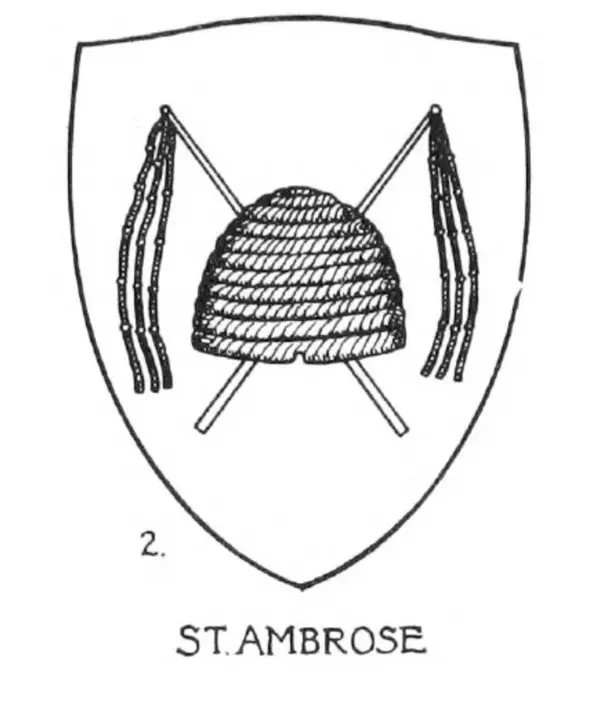St. Ambrose Church Father and his Symbol
St. Ambrose Church Father and His Symbol
St. Ambrose Church Father and his Symbol:
Today, December 7th, we celebrate St. Ambrose, one of the patriarchs of Christianity.
Origins
Born as Aurelius Ambrosius in 334 A.D., the man we know as St. Ambrose grew up in Gaul where his father held a high post as prefecture. It is said that a swarm of bees visited the infant Ambrose, landing upon his eyes and lips. This tradition claims to be the source of Ambrose’s ability later in life to speak in honeyed, caring words. So, the beehive has become the symbol most frequently associated with St. Ambrose because it is a symbol of eloquence.
Ambrose came from a Christian family. His great-aunt was martyred as a virgin for refusing to make sacrifices; her name was Soteris. Many Bishops and even the Pope visited the family while Ambrose was a child. And in 353 A.D. on the feast of Epiphany, Marcellina, the sister of Ambrose, consecrated her virginity to God. She received the veil in the Vatican Basilica from the Pope but continued to live at her parent’s home for the rest of her days.
Ambrose’s Remarkable Journey
Although residents in Gaul, Ambrose’s family moved to Italy after the Roman government fell into turmoil when Constantine the Great died. Like his father before him, Ambrose became counselor prefect. He governed northern portions of Italy, with the central seat of power out of Milan. When the bishop of Milan died, Ambrose oversaw the election council to keep the peace between the Arians & the Christians faithful to the council of Nicaea. The election council was so impressed, that they elected Ambrose the bishop. Ambrose was not well-versed in Theology and had never been baptized. But in 374, he was baptized and installed as the Bishop of Milan.
Throughout his vocation, Ambrose did many impressive acts. The Arians thought he would be neutral to their cause, but in fact, he proved a staunch opponent of Arianism. As a learned man, he was gifted with the ability to write beautiful hymns, some of which we sing in our churches today. Practicing what he believed, Ambrose was a firm advocate for the purity of virginity and the act of celibacy.
St. Ambrose: The Scourges Symbol
The scourges in the above symbol for St. Ambrose relate to the ex-communication of Emperor Theodosius for his massacre of the people of Thessalonica. The Emperor could not receive absolution until he did penance in public for his sins. Among the other symbols associated with St. Ambrose are a pen, a book of ancient music, a chalice, a writing table and books, a bull, a dove, and a goose. His zeal to defend the church against the Arians and pagans is often depicted as a heart with heraldic flames.
St. Ambrose: Contributions
And finally, Ambrose was a mentor to St. Augustine of Hippo and his mother Monica; even administering baptism to Augustine. Ambrose died in 397 A.D.; he died blessed with learning and life having been spent walking in the path of Christ.
St. Ambrose is revered as one of the Latin Church fathers which number four in all. He is in company with SS. Jerome, Augustine of Hippo, and Gregory the Great. There are also four Greek Church Fathers which include SS. Athanasius, Basil the Great, John Chrysostom, and Gregory of Nazianzus. Occasionally, the Church adds St. Cyril of Alexandria to this number of Church Fathers.
Christian Art
These men are frequently depicted in Christian art in many forms, including paintings and stained glass windows. The stained glass window in the above photo is from the Cathedral Basilica in Denver, Colorado, where one can find a wonderful collection of stained glass windows depicting not only St. Ambrose but also many of the other well-known Fathers of the Church.
Solo Dei Gloria
Be sure to visit our online store front Ecclesiastical Sewing where you may shop for Liturgical Fabrics, altar linen fabrics, church vestment-making patterns, liturgical machine embroidery designs, church vestment trims and notions and so much more. You may also find us on Ecclesiastical Sewing on Facebook, Twitter, and Pinterest. Sign up for our mailing list at the bottom of the page on our online store front and receive a free copy of our Small Linens Booklet as our way of saying thank you for following along.
Bibliography
Paredi, Angelo. Saint Ambrose: His Life and Times. Notre Dame, Indiana: University of Notre Dame Press, 1964.
The Chasuble Percy Dearmer
St. Thomas Aquinas
Memories and Vestment Photos from Summer Travels
Hope in the Midst of Tragedy – Trinity Evangelical Lutheran Church Milwaukee








 RSS - Posts
RSS - Posts
You must be logged in to post a comment.